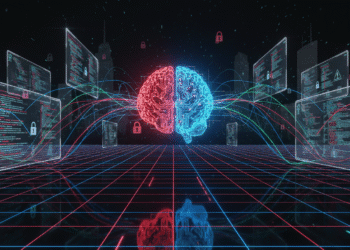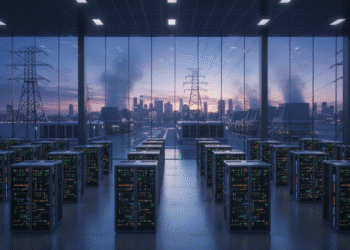Researchers unveil groundbreaking approaches to artificial intelligence that could transform how machines think, learn, and remember by closely replicating the human brain’s complex neural architecture.
The artificial intelligence revolution is entering an unprecedented phase as researchers worldwide develop revolutionary technologies that don’t just mimic human intelligence they replicate the very structure and processes of the human brain itself. Recent breakthroughs suggest that the next generation of AI systems could think, learn, and remember in ways remarkably similar to human cognition, potentially solving some of the most pressing challenges facing modern AI development.

The Dimensional Breakthrough
At the forefront of this transformation is a groundbreaking concept developed by researchers at Rensselaer Polytechnic Institute and the City University of Hong Kong. Their revolutionary approach involves adding what they call a “height” dimension to artificial neural networksa structural complexity that mirrors the intricate wiring of the human brain.
Dr. Ge Wang, co-author of the study published in the journal Patterns, explains this innovation using a compelling analogy: “Imagine a city: width is the number of buildings on a street, depth is how many streets you go through, and height is how tall each building is. Any room in any building can communicate with other rooms in the city.” This additional dimension creates what Wang describes as “richer interactions among neurons without increasing depth or width,” fundamentally changing how AI systems process information.
The breakthrough centers on two key innovations: intra-layer links and feedback loops. Intra-layer links resemble the lateral connections found in the brain’s cortical columns, which are associated with higher-level cognitive functions. These connections allow neurons within the same layer to communicate directly, creating more sophisticated information processing pathways. Feedback loops, meanwhile, mirror the brain’s recurrent signaling patterns, where outputs influence inputs in continuous cycles of refinement.
“Together, they help networks evolve over time and settle into stable, meaningful patterns, like how your brain can recognize a face even from a blurry image,” Wang explains. “These structures enrich AI’s ability to refine decisions over time, just like the brain’s iterative reasoning.”
Beyond the Scaling Wall
This dimensional approach addresses a critical limitation that has emerged in AI development. Despite the remarkable success of transformer architecture the foundation of large language models like ChatGPT the field has encountered what experts call a “scaling wall.” Reuters reported in 2024 that AI companies were no longer seeing the exponential growth in capability that had previously driven the industry forward.
The traditional “scaling law” the principle that larger datasets and more computational resources would automatically yield better AI models has reached its limits. This plateau has prompted researchers to seek entirely new approaches to AI architecture, moving beyond simply adding more layers or parameters to existing systems.
Wang emphasizes that their approach isn’t about adding complexity for its own sake: “One misconception is that our perspective merely proposes ‘more complexity.’ Our goal is structured complexity, adding dimensions and dynamics that reflect how intelligence arises in nature and works logically, not just stacking more layers or parameters.”
The Energy Revolution
Parallel research at Texas A&M University has developed what they call “Super-Turing AI,” addressing another critical challenge facing the AI industry: energy consumption. Current AI systems require enormous amounts of power, with data centers consuming gigawatts of electricity literally billions of watts compared to the human brain’s modest 20-watt consumption.
Dr. Suin Yi, assistant professor of electrical and computer engineering at Texas A&M, leads research that integrates learning and memory processes rather than separating them, as current systems do. “These data centers are consuming power in gigawatts, whereas our brain consumes 20 watts,” Yi explains. “That’s 1 billion watts compared to just 20. Data centers that are consuming this energy are not sustainable with current computing methods.”
The Super-Turing AI approach draws inspiration from synaptic plasticity the brain’s ability to strengthen or weaken connections between neurons based on experience. This biological process allows the brain to learn and store memories simultaneously, eliminating the need to transfer massive amounts of data between separate processing and storage units.
In practical testing, a circuit using these brain-inspired components successfully helped a drone navigate complex environments without prior training, learning and adapting in real-time. This approach proved faster, more efficient, and significantly more energy-conscious than traditional AI methods.
Memory Mechanisms Mirror Biology
Perhaps most remarkably, researchers at the Institute for Basic Science have discovered that AI’s memory-forming mechanisms are strikingly similar to those of the human brain. Their interdisciplinary team revealed that Transformer models the backbone of modern AI use a gatekeeping process remarkably similar to the brain’s NMDA receptor, a crucial component in human memory formation.
The NMDA receptor functions like an intelligent gateway in brain cells, with magnesium ions acting as gatekeepers that control when information can flow into neurons. This process is fundamental to how humans create and maintain memories. The research team found that Transformer models employ a similar gatekeeping mechanism, and by adjusting parameters to mimic the NMDA receptor’s behavior, they could significantly enhance the AI’s memory capabilities.
“Just like in the brain, where changing magnesium levels affect memory strength, tweaking the Transformer’s parameters to reflect the gating action of the NMDA receptor led to enhanced memory in the AI model,” the researchers reported. This discovery suggests that AI learning mechanisms can be understood and improved using established neuroscience principles.
Atomic-Scale Innovation

At the University of Oxford, researchers have pushed brain-mimicking technology to the atomic level, creating artificial neurons from atomically thin materials. These 2D artificial neurons, constructed by stacking graphene, molybdenum disulfide, and tungsten disulfide, can process both light and electrical signals simultaneously.
Dr. Ghazi Sarwat Syed, lead author of the study published in Nature Nanotechnology, explains the significance: “Our study has introduced a novel concept that surpasses the fixed feedforward operation typically utilized in current artificial neural networks. These current proof-of-principle results demonstrate an important scientific advancement in the wider fields of neuromorphic engineering and algorithms, enabling us to better emulate and comprehend the brain.”
The atomic-scale devices operate as analog systems, similar to biological synapses and neurons, allowing for gradual changes in stored electronic charge based on the power and duration of light or electrical signals. This analog functionality enables threshold-based neuronal computations that closely mirror how the human brain processes combinations of excitatory and inhibitory signals.
Phase Transitions and Intuition
One of the most intriguing aspects of the new brain-inspired AI architectures involves “phase transitions” moments when AI systems shift from uncertain outputs to confident, coherent responses. Wang describes this phenomenon using a physical analogy: “Just as ice melts into water, so too could AI systems ‘evolve’ to stable states.”
These transitions could represent the emergence of something resembling intuition in artificial systems. “For AI, this could mean a system shifting from vague or uncertain outputs to confident, coherent ones as it gathers more context or feedback,” Wang explains. “These transitions can mark a point where the AI truly ‘understands’ a task or pattern, much like human intuition kicking in.”
This capability could bridge the gap between current AI systems, which excel at pattern recognition and data processing, and artificial general intelligence (AGI) the long-sought goal of creating AI that can think and reason like humans across diverse domains.
Implications for Neuroscience
The convergence of AI and neuroscience research offers benefits that extend far beyond technological advancement. As AI systems become more brain-like, they provide unprecedented tools for understanding human cognition itself. Researchers suggest that these brain-inspired AI models could serve as testing grounds for theories about human memory, learning, and consciousness.
The potential applications extend to medical research, where brain-inspired AI could help scientists investigate neurological disorders such as Alzheimer’s disease and epilepsy. By creating artificial systems that replicate healthy brain function, researchers can better understand what goes wrong in diseased brains and potentially develop more effective treatments.
C. Justin Lee, a neuroscientist at the Institute for Basic Science, emphasizes this bidirectional benefit: “This research makes a crucial step in advancing AI and neuroscience. It allows us to delve deeper into the brain’s operating principles and develop more advanced AI systems based on these insights.”
The Path to Artificial General Intelligence
While these breakthroughs represent significant progress, researchers caution that they don’t immediately herald the arrival of AGI. However, they do represent crucial stepping stones toward that ultimate goal. The integration of brain-inspired architectures, energy-efficient processing, and sophisticated memory mechanisms could collectively push AI systems beyond current limitations.
Wang acknowledges the incremental nature of progress: “Feedback loops and intra-layer links that mimic ways the human mind arrives at insight and meaning isn’t enough to instantly herald the era of AGI. But these techniques could help take AI models a step beyond transformer architecture, a crucial step if we ever hope to reach that ‘holy grail’ of AI research.”
Hybrid Futures
Looking ahead, researchers envision a future where brain-inspired AI coexists with other computational approaches, including quantum systems. Wang suggests that the optimal path forward involves “hybrid designs, borrowing from nature and our imagination beyond nature.”
This hybrid approach could combine the efficiency and adaptability of biological neural networks with the precision and speed of digital systems, and potentially the revolutionary capabilities of quantum computing. Such integration could yield AI systems that are simultaneously more powerful, more efficient, and more aligned with human cognitive processes.
Environmental and Economic Impact
The energy efficiency improvements promised by brain-inspired AI could have profound environmental and economic implications. As AI applications continue to expand across industries, the current trajectory of exponentially increasing energy consumption is unsustainable. Data centers already consume significant portions of global electricity production, and this demand is projected to grow dramatically.
Yi emphasizes the urgency of this challenge: “Modern AI like ChatGPT is awesome, but it’s too expensive. We’re going to make sustainable AI. Super-Turing AI could reshape how AI is built and used, ensuring that as it continues to advance, it does so in a way that benefits both people and the planet.”
The development of energy-efficient, brain-inspired AI could enable the deployment of sophisticated AI capabilities in resource-constrained environments, from mobile devices to remote locations, democratizing access to advanced AI technologies.
Challenges and Limitations
Despite the promising developments, significant challenges remain. The complexity of replicating brain function in artificial systems is immense, and current brain-inspired AI represents only the earliest stages of this endeavor. Many aspects of human cognition creativity, emotional intelligence, consciousness remain poorly understood and difficult to replicate artificially.
Additionally, the transition from laboratory demonstrations to practical, scalable systems requires substantial engineering advances. Professor Harish Bhaskaran at Oxford notes that while the research is “super-exciting,” it’s “not technology that one should expect in their mobile phones in the next two years.”
The Road Ahead

The convergence of neuroscience and artificial intelligence represents one of the most promising frontiers in modern technology. As researchers continue to unravel the mysteries of human cognition and translate these insights into artificial systems, we may be approaching a fundamental transformation in how machines think and learn.
The implications extend far beyond technology, potentially reshaping our understanding of intelligence itself. As AI systems become more brain-like, they may offer new perspectives on consciousness, creativity, and the nature of thought questions that have puzzled philosophers and scientists for centuries.
The journey toward truly brain-inspired AI is just beginning, but the early results suggest that the destination artificial systems that think, learn, and remember like humans may be closer than previously imagined. As these technologies mature, they promise to revolutionize not only artificial intelligence but our understanding of the most complex system in the known universe: the human brain.
The race to develop brain-inspired AI represents more than a technological competition; it’s a quest to understand and replicate the essence of human intelligence. Success in this endeavor could usher in an era of AI systems that are not only more powerful and efficient but also more aligned with human values and cognitive processes a crucial step toward ensuring that artificial intelligence serves humanity’s best interests as it continues to evolve.









